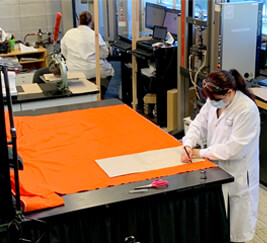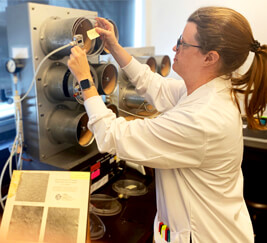From the roughness of a fabric to the compression factor of an insulating fiber to the solar reflection index of a roofing membrane, physical testing gathers a large quantity of tests intended to better understand the nature of a textile or geosynthetic material, and its behaviour under various physical conditions.

Preparation of geosynthetic materials for thermal expansion measurements

Preparation of textile samples in the conditioned laboratory

Pilling Resistance of Textile fabrics Test (ASTM D3512)
At CTT Group, physical testing is grouped into four main categories: dimensional testing, manufacturing characterization, thermophysical characteristics and optical properties.
DIMENSIONAL TESTING
This category includes tests that concern the dimensions and dimensional variations of a material. Our most common tests can measure:
- The thickness of a membrane, the coating of a textile (with or without pressure);
- The compression factor of a material under pressure;
- The density of a material;
- The dimensional stability of a material (under heat, moisture or both);
MANUFACTURING CHARACTERIZATION
This category concerns the nature of the material. Manufacturing tests can be used to analyze the defects of a material, or to characterize the products of a supplier. They are used to evaluate or measure such things as:
- The context (e.g., the number of threads per inch of a fabric);
- The type of weaving (the weave) or knit (binding);
- The type of yarn;
THERMOPHYSICAL PROPERTIES
As its name indicates, thermophysical testing concerns the reactions of a textile or geosynthetic material subjected to various thermal constraints. At CTT Group, we perform some unique tests in the industry to measure the thermal properties of finished products, using a thermal head (toques, hoods), a thermal hand (gloves) and a thermal foot (boots). Other common tests include:
- Melting, crystallization, glass transition temperature analysis (ASTM D3418);
- Coefficient of thermal expansion (ASTM E831 or ASTM D696);
- Thermal conductivity and effusivity (ASTM D7984);
- Thermal resistance, cold insulating capacity, CLO value (ISO 11092, ASTM F1868);
OPTICAL PROPERTIES
Tests that address the optical properties of a textile or geosynthetic material are used to evaluate the color (ASTM E308 or E1164), brightness (ASTM D523 or ISO 2813), solar reflectance (ASTM E424), or retroreflectivity of a material (ASTM E809 for retroreflective strips on ANSI/ISEA 107 and CSA Z96 safety vests, for example). At CTT Group, we can also measure the UV protection factor of a textile, or its behavior under infrared and near-infrared radiation.






